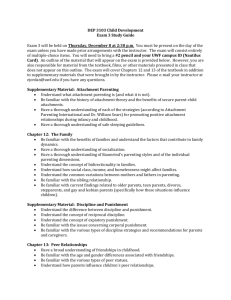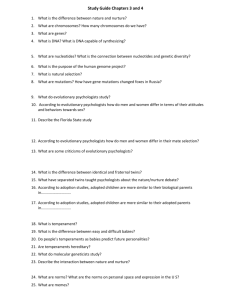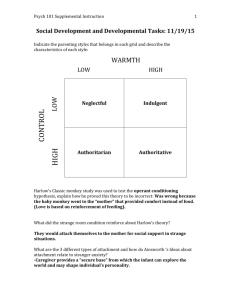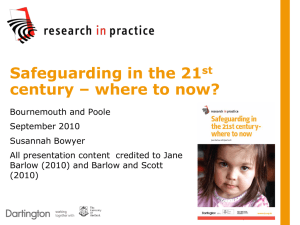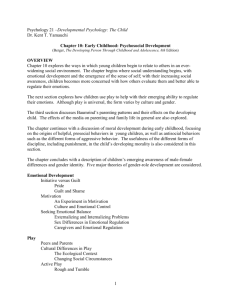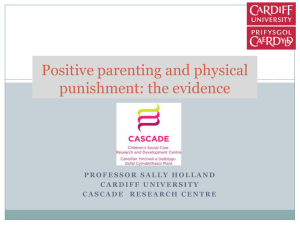File
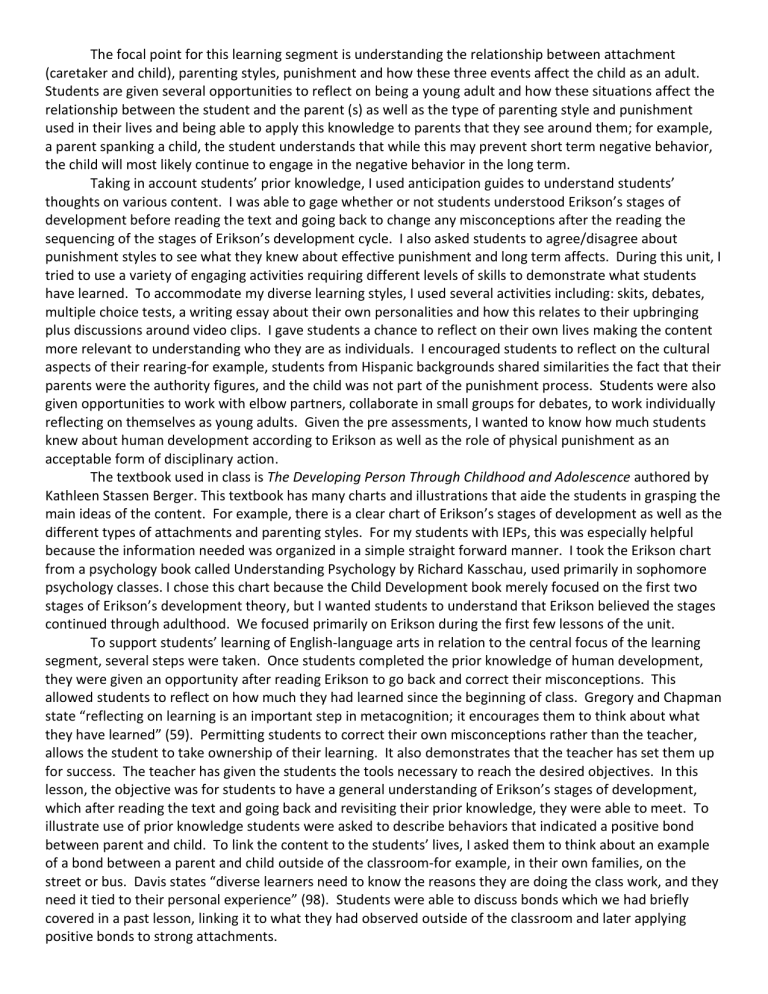
The focal point for this learning segment is understanding the relationship between attachment
(caretaker and child), parenting styles, punishment and how these three events affect the child as an adult.
Students are given several opportunities to reflect on being a young adult and how these situations affect the relationship between the student and the parent (s) as well as the type of parenting style and punishment used in their lives and being able to apply this knowledge to parents that they see around them; for example, a parent spanking a child, the student understands that while this may prevent short term negative behavior, the child will most likely continue to engage in the negative behavior in the long term.
Taking in account students’ prior knowledge, I used anticipation guides to understand students’ thoughts on various content. I was able to gage whether or not students understood Erikson’s stages of development before reading the text and going back to change any misconceptions after the reading the sequencing of the stages of Erikson’s development cycle. I also asked students to agree/disagree about punishment styles to see what they knew about effective punishment and long term affects. During this unit, I tried to use a variety of engaging activities requiring different levels of skills to demonstrate what students have learned. To accommodate my diverse learning styles, I used several activities including: skits, debates, multiple choice tests, a writing essay about their own personalities and how this relates to their upbringing plus discussions around video clips. I gave students a chance to reflect on their own lives making the content more relevant to understanding who they are as individuals. I encouraged students to reflect on the cultural aspects of their rearing-for example, students from Hispanic backgrounds shared similarities the fact that their parents were the authority figures, and the child was not part of the punishment process. Students were also given opportunities to work with elbow partners, collaborate in small groups for debates, to work individually reflecting on themselves as young adults. Given the pre assessments, I wanted to know how much students knew about human development according to Erikson as well as the role of physical punishment as an acceptable form of disciplinary action.
The textbook used in class is The Developing Person Through Childhood and Adolescence authored by
Kathleen Stassen Berger. This textbook has many charts and illustrations that aide the students in grasping the main ideas of the content. For example, there is a clear chart of Erikson’s stages of development as well as the different types of attachments and parenting styles. For my students with IEPs, this was especially helpful because the information needed was organized in a simple straight forward manner. I took the Erikson chart from a psychology book called Understanding Psychology by Richard Kasschau, used primarily in sophomore psychology classes. I chose this chart because the Child Development book merely focused on the first two stages of Erikson’s development theory, but I wanted students to understand that Erikson believed the stages continued through adulthood. We focused primarily on Erikson during the first few lessons of the unit.
To support students’ learning of English-language arts in relation to the central focus of the learning segment, several steps were taken. Once students completed the prior knowledge of human development, they were given an opportunity after reading Erikson to go back and correct their misconceptions. This allowed students to reflect on how much they had learned since the beginning of class. Gregory and Chapman state “reflecting on learning is an important step in metacognition; it encourages them to think about what they have learned” (59). Permitting students to correct their own misconceptions rather than the teacher, allows the student to take ownership of their learning. It also demonstrates that the teacher has set them up for success. The teacher has given the students the tools necessary to reach the desired objectives. In this lesson, the objective was for students to have a general understanding of Erikson’s stages of development, which after reading the text and going back and revisiting their prior knowledge, they were able to meet. To illustrate use of prior knowledge students were asked to describe behaviors that indicated a positive bond between parent and child. To link the content to the students’ lives, I asked them to think about an example of a bond between a parent and child outside of the classroom-for example, in their own families, on the street or bus. Davis states “diverse learners need to know the reasons they are doing the class work, and they need it tied to their personal experience” (98). Students were able to discuss bonds which we had briefly covered in a past lesson, linking it to what they had observed outside of the classroom and later applying positive bonds to strong attachments.
Students need to understand that through strong attachments involving a parenting style in which both the parent and the child take an active role and in which punishment entails talking about the child’s negative behavior, making decisions that take into consideration the individual child and his/her needs was the main objective in this unit. The first part of the lesson for students to understand the recognition of a strong attachment. Strong attachments are not necessarily the child clinging to the parent-a common misconception- but rather the child is exploring the world around him while still getting support from the caretaker. How does this type of attachment develop? The key factors playing a role in a strong attachment involves a style in which the parent listens to the child but still makes the decisions, taking into consideration the child’s point of view. Along with parenting comes punishment, which is always a point of debate because so many people believe that physical punishment is effective. Students were able to understand that punishment should be made taking into consideration what the child needs to change his negative behavior in the long term. This connection came at the end of the unit when students were asked to reflect upon parenting styles and how punishment affected the individual growing up. Attachment also affects how the child matured and whether or not he/she was happy and independent. Students were able to examine four different attachment styles and how the child becomes independent or dependent on the caretaker depending on which style was present. Students were also able to look at different parenting styles and how each one affected the individual as an adult. The last part of the lesson was a debate in which students engaged in arguments on whether or not physical punishment was effective and how not using physical punishment could result in lasting positive behaviors.
To support students with IEPs, several modifications were made. Students were always given graphic organizers to support the reading to help narrow down the main idea. During note taking, students were not required to take Cornell notes which is a school-wide procedure. When students took a role in the debate, examples and sentence stems were provided for the student’s role to show what was expected. The writing piece was supported with a model and think aloud to the whole class of how to develop and organize the paper. The students were also given a graphic organizer to plan their thoughts prior to writing the actual paper. The last part of the unit was the test in which students with IEPs were given extended time, the opportunity to use their notes if listed in the IEP, and a room outside of the classroom to complete the test.
Some of the key vocabulary for this unit includes:
*insecure attachment
*secure attachment
*synchrony
*Strange Situation
*authoritative (parenting style)
*authoritarian (parenting style)
*permissive (parenting style)
To help students grasp these key concepts, graphic organizers were used that helped students write down characteristics of certain vocabulary words. For example, students were given graphic organizers to support each word. The textbook also provided textual organization in that each topic was described separately especially for the attachment reading. For students with IEPs, the textbook has a chart in which students are able to see the characteristics of each attachment type and how this would look when a parent and child were interacting. To support students’ understanding of synchrony, a Prezi was used to make the content from the text straightforward about how this affects the bond between parent and child. Rather than having students read from the textbook, the information was presented in a more simplistic way-which for lower level students helped them understand the vocabulary term. During the parenting styles section of the unit, students were given a graphic organizer in which they were required to write at least four details about each parenting style and the effects it had on the child.
For informal assessments, students were given exit slips as well as check for understandings after reading from the text to assess their learning. The exit slips were designed around the objectives for the day and gave insight on whether or not students met these objectives. The check for understandings after the
reading were used as an “in the moment” assessment to clear up any misconceptions from the reading before moving on to the activity in which students were being asked to apply their new knowledge. The formal assessments consisted of a written composition in which students were to relate parenting styles to the effects on the individual and consider their own parents and how this has shaped them into the young adult that they are today. The other formal assessment was a multiple choice test that covered the main idea and some supporting detail questions concerning the entire unit. To accommodate the students, a think aloud was done to show how to organize the written assessment as well as how to create a clear thesis. Graphic organizers were also provided for students to get their thoughts on paper in a sequential manner.

